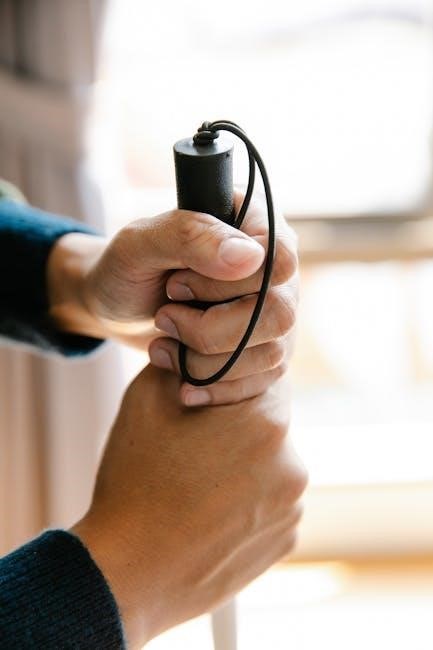This portable guide provides essential first aid tips for emergencies, designed to fit in your pocket or vehicle for quick access.
It covers severe bleeding, burns, and life-saving techniques like CPR, ensuring you’re prepared to act swiftly and confidently in critical situations.
Overview of the Guide’s Purpose
This guide is designed to empower individuals with essential first aid knowledge, ensuring preparedness for emergencies. It covers a wide range of situations, from severe injuries to burns, providing clear, actionable steps. The portable format allows it to be easily carried in a pocket or vehicle, making it accessible whenever needed. Aimed at non-experts, the guide simplifies life-saving techniques, emphasizing quick and confident responses. Its purpose is to bridge the gap between an emergency occurring and professional help arriving, ensuring better outcomes through immediate, informed care.
Importance of First Aid Preparedness
First aid preparedness is crucial for saving lives and reducing the severity of injuries or illnesses. Immediate response can make a significant difference in emergencies, often preventing minor issues from escalating. Everyone, regardless of medical expertise, can benefit from basic first aid knowledge. This guide empowers individuals to act confidently and effectively in critical situations, whether at home, work, or on the go. By understanding essential techniques, people can provide vital care until professional help arrives, highlighting the importance of being prepared and informed to ensure better outcomes in emergencies.
Essential First Aid Techniques
Mastering ABCs (Airway, Breathing, Circulation) is vital. Learn to control severe bleeding, assess injuries, and provide care until professional help arrives, ensuring effective emergency response.
ABCs of Life Support
The ABCs of life support—Airway, Breathing, and Circulation—are critical first aid steps. Ensure the airway is open by tilting the head and lifting the chin.
Check for breathing by listening and feeling for breath. If absent, begin rescue breathing.
Maintain circulation with chest compressions (30:2 ratio) if no pulse is detected.
These steps sustain life until professional help arrives, making them indispensable in emergencies.
Severe Bleeding: Immediate Response
Severe bleeding requires swift action to prevent shock and further complications. Apply direct pressure using a clean cloth or gauze, pressing firmly on the wound.
Elevate the injured limb above heart level to reduce blood flow to the area.
If bleeding doesn’t stop, use a tourniquet or hemostatic dressing if available.
Avoid removing any embedded objects; stabilize and seek immediate medical help.
These steps are vital to control bleeding and stabilize the individual until professional care is obtained.
Burns and Scalds: Cooling and Care
For burns and scalds, immediate cooling is crucial to reduce tissue damage. Hold the affected area under tepid running water for at least 20 minutes.
Remove any clothing or jewelry near the burn, as these can stick to the skin as it swells.
Do not apply ice, butter, or other substances, as they can worsen the injury.
After cooling, apply a sterile, non-stick dressing and seek medical attention if the burn is severe or covers a large area.
For minor burns, topical antibiotic ointment and loose clothing can aid healing.
Proper care helps prevent infection and promotes recovery.
CPR and Resuscitation
Master CPR techniques to restore circulation and breathing in cardiac emergencies. Follow the 30:2 ratio for compressions and breaths, continuing cycles until medical help arrives.
Adult Resuscitation Techniques
Adult resuscitation focuses on restoring breathing and circulation. Begin with 30 chest compressions, followed by two rescue breaths, maintaining a ratio of 30:2. Ensure the chest compressions are deep, about 2-3 inches, and allow full recoil. If trained, use an Automated External Defibrillator (AED) for shockable rhythms. Continue cycles until emergency services arrive or the person regains consciousness. Always prioritize hand hygiene and use personal protective equipment like gloves and a face mask. For further guidance, refer to downloadable first aid guides or online tools for detailed CPR steps and resources.
Recovery Position: Proper Application
The recovery position is crucial for unconscious individuals to maintain an open airway. Place the person on their side, with the upper leg bent to stabilize the body. Tilt their head back gently to ensure the airway remains clear, preventing obstruction by vomit or fluids. Avoid moving the person excessively unless in immediate danger. This technique helps prevent asphyxiation and is essential in first aid situations until professional help arrives. Always follow proper hygiene practices and use protective gear when applying the recovery position to ensure safety for both the casualty and the responder.

General First Aid Tips
Always prioritize hand hygiene, use gloves and face masks for protection, and assess the situation before acting. Infection control is key to preventing further harm.
Hand Hygiene in First Aid
Proper hand hygiene is crucial in first aid to prevent infection spread. Always wash hands with soap and water or use an alcohol-based sanitizer for at least 20 seconds before and after providing care. This simple step significantly reduces the risk of transmitting germs. Even when wearing gloves, handwashing remains essential, as gloves do not replace the need for cleanliness. Prioritize hand hygiene to ensure both the caregiver and casualty remain protected. Clean hands save lives and are the foundation of effective first aid practices.
Use of Gloves and Face Masks
Wearing gloves and face masks is vital in first aid to protect both the caregiver and casualty from potential infections. Gloves prevent direct contact with bodily fluids, reducing the risk of disease transmission, while face masks minimize exposure to airborne pathogens. Choose disposable, medical-grade gloves for a snug fit and optimal protection. Always discard gloves carefully after use to avoid cross-contamination. Face masks should cover the nose and mouth securely. These precautions ensure a safer environment for providing care and are essential components of infection control in emergency situations. They are simple yet critical barriers in maintaining hygiene standards during first aid interventions.
Infection Control Measures
Infection control is critical in first aid to prevent the spread of pathogens. Always wash hands with soap and water or use an alcohol-based sanitizer before and after providing care. Wear disposable gloves when handling bodily fluids to avoid direct contact. Masks should be used if there’s a risk of airborne transmission. Properly dispose of soiled items, such as gloves and masks, in sealed bags. Clean and disinfect any surfaces or equipment after use. These measures ensure a safer environment for both the caregiver and the casualty, reducing the risk of infection transmission during emergency situations.

Emergency Situations
Act quickly in emergencies with essential tips from the pocket guide, covering severe injuries, burns, and sudden illnesses to help you respond effectively in critical moments.
Handling Choking Incidents
Choking is a life-threatening emergency requiring immediate action. If someone is choking, remain calm and encourage them to cough to dislodge the object.
For adults and children, perform back blows between the shoulder blades. If this fails, use abdominal thrusts to create pressure and force the object out.
For infants, use chest thrusts or back blows. If the person becomes unresponsive, begin CPR if trained to do so.
Always prioritize dislodging the object and restoring breathing to prevent serious complications.
Cardiopulmonary Resuscitation (CPR) Steps
CPR is a critical lifesaving technique for cardiac arrest. Begin by calling emergency services and checking the person’s breathing and pulse.
Place the heel of one hand on the center of the chest, cover it with the other, and perform compressions at a rate of 100-120 per minute.
For trained responders, provide 30 compressions followed by two breaths. Continue this cycle until professional help arrives or the person regains consciousness.
If an AED is available, use it as instructed to deliver a shock if needed. Stay with the person until medical assistance arrives.
Proper training is essential for effective CPR, so consider enrolling in a certified course for comprehensive guidance.

Additional Resources
Access downloadable first aid guides, online tools, and apps for emergencies. These resources provide updated techniques and practical advice for immediate care and preparedness.
Downloadable First Aid Guides
Find free, printable pocket-sized first aid guides online. These resources cover essential techniques for emergencies, including severe bleeding, burns, and CPR. Available as PDFs, they are easy to access and share. Many organizations, like the Red Cross and St John Ambulance, offer these guides. They are designed to be concise and portable, ensuring quick reference during critical situations. Downloadable guides often include step-by-step instructions and visual aids, making them user-friendly. Visit websites like redcross.ca or sja.ca to get your copy and stay prepared for emergencies. These guides are invaluable for home, work, or travel use.
Online Tools for First Aid Planning
Utilize online tools to enhance your first aid preparedness. Websites like St John Ambulance and Red Cross offer resources to assess risks and create tailored first aid plans. These tools provide interactive guides, checklists, and training materials to ensure you’re equipped for emergencies. They often include step-by-step instructions and videos for techniques like CPR and bleeding control. Some platforms also offer customizable kits based on your specific needs. Access these tools to stay informed and update your first aid knowledge regularly. They are ideal for both personal and workplace safety planning, ensuring you’re always ready to respond effectively.

Specialized First Aid Tips
Discover tailored advice for pets, home safety, and travel, ensuring comprehensive care in unique situations with practical, easy-to-follow guidance for everyday emergencies.
Safety Tips for Home Use
Ensure a safe environment by storing hazardous substances out of reach and installing safety devices like smoke detectors and secure gates. Keep emergency numbers handy and maintain a well-stocked first aid kit. Regularly inspect your home for potential hazards, such as loose wires or slippery floors, and address them promptly. Teach family members basic first aid and emergency procedures to foster preparedness. Prevent accidents by securing heavy furniture and using non-slip mats in bathrooms. Stay vigilant and proactive to create a safer living space for everyone.
Pet First Aid Manual
A essential guide for pet owners, this manual provides detailed care instructions for common injuries and illnesses in pets. Learn how to handle wounds, fractures, and signs of distress. Understand proper wound cleaning techniques and when to seek veterinary help. The guide also covers choking incidents and heatstroke prevention. Tips on creating a pet first aid kit and recognizing life-threatening conditions are included. Designed to be portable, it ensures you’re prepared to act quickly during emergencies. Keep it handy at home or while traveling with your pet for immediate reference and peace of mind.
Holiday and Travel Safety
Stay safe during travels with essential tips tailored for holidays and trips. Always pack a mini first aid kit with band-aids, antiseptics, and pain relievers. Research local emergency numbers and medical facilities at your destination. Be mindful of local health risks and take preventive measures. Avoid risky activities, especially in unfamiliar environments. Stay hydrated and protect yourself from the sun. Learn basic first aid for common travel incidents, such as sprains or insect bites. Keep emergency contacts handy and ensure someone knows your itinerary. A little preparation can make a big difference in ensuring a safe and enjoyable journey.
This pocket guide empowers you to act confidently in emergencies, ensuring quick and effective care. Always stay prepared and informed to save lives and prevent further harm.
Final Thoughts on First Aid Preparedness
First aid preparedness is crucial for everyone, as emergencies can occur unexpectedly. Having a pocket first aid guide ensures you’re equipped with the knowledge to act swiftly and effectively.
Regularly reviewing and updating your first aid skills can make a significant difference in saving lives. Stay informed, download reliable guides, and always keep essential supplies handy.
Remember, quick action and proper techniques can prevent minor injuries from becoming severe. Ensure you’re prepared to respond confidently in any situation.
Your readiness could be the key to a positive outcome in an emergency. Stay proactive and prioritize first aid training for yourself and others.
Encouragement to Stay Informed
Staying informed about first aid practices is essential for effectively responding to emergencies.
Download free resources like the pocket first aid guide PDF to access practical tips and life-saving techniques anytime, anywhere.
Regularly review and update your skills to stay current with the latest first aid recommendations.
Your knowledge and preparedness can make a critical difference in saving lives and handling emergencies confidently.

About the Author
The author, a certified medical professional, specializes in emergency care and first aid training. They created this guide to empower individuals with life-saving knowledge.
Credentials and Expertise
The author holds certifications in emergency medical response and first aid instruction, with over a decade of experience in training individuals and organizations. Affiliated with reputable medical advisory groups, they specialize in developing practical, evidence-based first aid protocols. Their expertise includes creating accessible guides for non-experts, ensuring life-saving techniques are easy to learn and apply. The author has contributed to national first aid guidelines and regularly collaborates with organizations like St John Ambulance to update and refine emergency care practices. Their work emphasizes hands-on training and real-world application, making them a trusted authority in the field of first aid education.
Additional Resources from the Author
The author offers a range of supplementary materials, including video tutorials, downloadable checklists, and interactive quizzes, to enhance first aid learning. Their website features a comprehensive FAQ section addressing common emergencies and misconceptions. Additionally, the author provides a free first aid app with step-by-step guides and emergency contact directories. For deeper learning, they recommend their online certification courses and a podcast series discussing real-life emergency scenarios. These resources are designed to complement the pocket guide, ensuring users are well-equipped to handle various situations with confidence and expertise.
